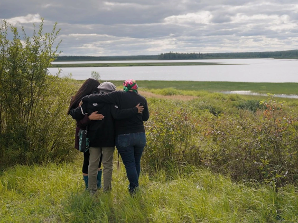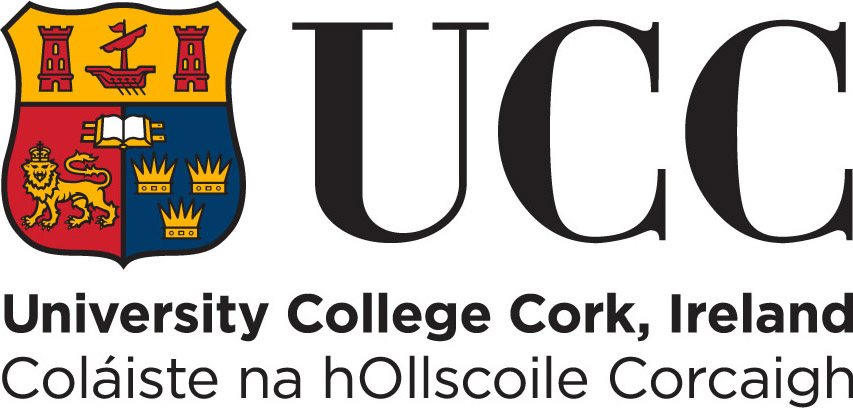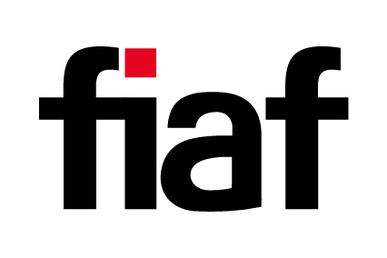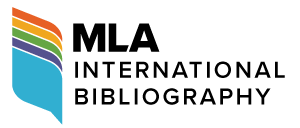“Stories Are in Our Bones!” From mispon to Ācimowin: A Conversation with Janine Windolph, in Memory of Trudy Stewart
Janine Windolph and Sheila Petty
[PDF]
Abstract
As we talk-write this essay-conversation, we combine our positionality as Atikamekw and Woodland Cree storyteller (Janine Windolph) and settler Canadian (Sheila Petty), our expertise in screen media production, curation and research, and our dedication to linguistic, cultural, and representational sovereignty in Indigenous art and knowledge production. In Indigenous research practices and approaches to curatorial research and methods, it is important to begin by introducing ourselves. Through this “conversational method of Indigenous inquiry” (Christian 43), we intend to probe the history of two Indigenous focused film festivals in Saskatchewan—mispon (2006–2018) and Ācimowin (2024–)—and discover how they embrace a methodology of story work, hospitality, and story-gifting to build cultural and representational sovereignty into their curatorial practices and presentation. In concert with this, we will also discuss Janine Windolph’s films, showcased at both festivals, Trudy Stewart’s films and screen work, and their embeddedness in Indigenous representational sovereignty.
Article

Figure 1: Janine Windolph (left) and Trudy Stewart at the 2014 North American Indigenous Games in Regina. Courtesy Janine Windolph.
On 10 October 2019, the late Trudy Stewart (BFA’08) and Janine Windolph (BFA’06, MFA’11) were awarded the Crowning Achievement Award for Distinguished Professional Achievement at the 2019 University of Regina Alumni Crowning Achievement Awards. They were recognised for their incredible work in fostering Indigenous filmmaking in Saskatchewan. Trudy and Janine met while film students in the Department of Film at the University of Regina. Their creative relationship grew while working at mispon: A Celebration of Indigenous Filmmaking, Inc., and together, they mentored many young filmmakers who have gone on to national and international acclaim, such as Candy Fox, Danis Goulet and many others.[1] Together, Trudy and Janine produced award-winning documentaries about their homeland and search for personal and family roots and identities that screened at festivals around the world. From their work as statement gatherers for the Truth and Reconciliation Commission,[2] they produced RIIS from Amnesia: Uncovering the Forgotten Legacy in 2015, a short but powerful documentary that explores the shared colonial legacy of the Regina Indian Industrial School. Their belief was that they were stronger together and achieved much more in collaboration as filmmakers and storytellers than on their own.Filmmaking and film festival curation in Saskatchewan and Canada have been dominated by colonial settler narratives and imperatives, and stories about Indigenous peoples have mostly been told by non-Indigenous peoples. The control of one’s own story, told in one’s own Indigenous language, is a basic human right. In the context of his human rights research, Paul Gready has asked, “what responsibility do we have to the stories we hear, process and tell?” (177), as though in early anticipation of Anishinaabe writer, broadcaster and arts leader, Jesse Wente’s call for narrative sovereignty in Unreconciled: Family, Truth, and Indigenous Resistance. According to Wente, Indigenous “stories are a threat to the one Canada tells itself and the world” (169). Wente further explains that Canada is
a colonial settler state [whose] origins lie in a massive resource extraction project—the exploitation of the land’s natural bounty in order to enrich Europeans—that was often both illegal and murderous. In order to justify all that selfishness, greed, and violence, Canada used storytelling to craft an alternative history and identity. (169)[3]
This Canadian “master narrative” depicts settlers arriving in lands “to find no ‘real’ people”, only ‘primitive’ beings, whose land (in the settlers’ eyes) was purchased fairly and whose children required westocentric Canadian education to elevate “their societies toward a European ideal” (169). Like Wente, Janine Windolph and Trudy Stewart believe(d) that narrative sovereignty involves “nations [controlling] their own stories and the tools used in that storytelling” (168). Windolph and Stewart, however, take this idea one step further with their belief in the idea of collaboration: “We are all on a healing journey”, explains Windolph, when talking about the RIIS film, “and that we can do this all together makes it more powerful” (Grandish). This statement demonstrates her philosophical belief in the interrelatedness of human relationships, a founding principle of Indigenous storywork (Christian 42).
As we talk-write this essay-conversation, we combine our positionality as Atikamekw and Woodland Cree storyteller (Janine Windolph) and settler Canadian (Sheila Petty), our expertise in screen media production, curation and research, and our dedication to linguistic, cultural, and representational sovereignty in Indigenous art and knowledge production. In Indigenous research practices and approaches to curatorial research and methods, it is important to begin by introducing ourselves.
Tansi, tawâw! My name is Janine Windolph and I was born and raised in La Ronge, Saskatchewan (Treaty Six), and from my father’s side, I am Woodland Cree.[4] I currently live in Banff, Alberta (Treaty Seven). I am a member of Waswanipi Cree Nation, Quebec (James Bay Agreement) and on my mother’s side, I am a Atikamekw Cree. My last name Windolph is from my German grandfather Heinz Windolph. My documentary, feature film and film curations incorporate themes of family, ancestors, lineage, oral storytelling, (re)connections to land and community. For my personal films, I always incorporate food and hospitality practices that were connected to my cultural teachings from both north and southern Saskatchewan.Tansi, tawâw! My name is Sheila Petty. I was born on Treaty Six Territory in Saskatchewan, twenty miles south of Poundmaker First Nation. My father’s parents came to Canada from England in 1907 (I believe) during the Canadian Pacific drive to bring Western European settlers to Western Canada. My mother’s family came first to Ontario and then Saskatchewan from Western Europe and are a mix of Icelandic (Osland), English and Scottish (Anderson). Thus, these families, my forebears, were implicated in the colonization of these lands I now live and work on, especially those located on Treaty Six. My experience with Indigenous theoretical frameworks and research methods began through my work on sub-Saharan African cinema. I strongly believe that working in cultural contexts different from one’s own necessitates the development of respectful listening skills and openness to new experiences that are critical if one is to listen to, and understand, the goals of such artworks and artists. Within this context, I espouse the philosophy that applying Eurocentric frames of analysis to non-Eurocentric artworks and texts leads to a context of mistrust and rejection of cultural and representational sovereignty. I am honoured to speak with Janine, remember Trudy, and listen and learn.
Through this “conversational method of Indigenous inquiry” (Christian 43), we intend to probe the history of two Indigenous focused film festivals in Saskatchewan—mispon (2006–2018) and Ācimowin (2024–)—and discover how they embrace a methodology of story work, hospitality, and story-gifting to build cultural and representational sovereignty into their curatorial practices and presentation. In concert with this, we will also discuss Janine’s films—showcased at both festivals—Trudy’s films and screen work, and their embeddedness in Indigenous representational sovereignty.
In her scholarship on global Indigenous media, Pamela Wilson, building on previous work on Indigenous visual sovereignty by Michelle Raheja, proposed the term “indigenous representational sovereignty” to allow for the use of a “culture’s own logic” to control and organise “the process and product” of artistic creation (97). Wilson maintains that “indigenous representational sovereignty” has evolved in different ways over time as various peoples have appropriated film and video technology and made it their own (97). Visual sovereignty is but one facet of a holistic representation that encompasses sound, language and other knowledge forms.
Indigenous representational sovereignty is important to curatorial work as well. Indigenous curation strategies have always been “in one’s bones” because they are embodied elements of Indigenous holistic knowledge and ways of knowing and being in the world that are relational and non-hierarchical. Indigenous curators in Canada have asserted their agency as curatorial professionals since the 1960s and 1970s and more recently have begun telling their stories and documenting the process through scholarly work in the academy. Felicia Gay maintains that Indigenous curatorial methodologies are important to counter westocentric curatorial practices that are “traditionally hierarchical” (25). To be sure, there are varied approaches to Indigenous curation, such as Gay’s methodology of situating her practice within personal narratives (25), but overall it “prioritizes the aspirations, needs, and values of Indigenous peoples and knowledges” (McGregor et al. 1). Both Margaret Kovach and Felicia Gay assert that stories belong to place and that there are many ways to give stories back. We maintain that festivals and festival curation and programming are ways of “giving back” stories. They are acts of reciprocity that “[actualize] the principle of serving the community” and sharing stories and research results with those who have contributed or participated in the work (McGregor et al. 15). The curatorial team of a festival acts as a community, with a duty to transmit stories and knowledge once told, drawing on the principles of care, respect and reciprocity (15).
mispon: A Celebration of Indigenous Filmmaking, Inc.
PETTY: Tansi Janine! I’m delighted to talk with you today and listen to your stories—your life stories and filmmaking trajectory. I have seen all your films, and I am excited to discuss them today in the context of your work with mispon and, in turn, the acknowledgement of your work at Ācimowin. Can you tell me about the journey of your creative work and how you have developed your practice? Were you involved in film festival curation before turning to filmmaking?
WINDOLPH: Tansi Sheila! As a young child, I always wanted to make movies, but it wasn’t until I took a Film 100 course as an elective course that I realized there was a path to make that dream happen. I quickly changed my focus from Business Administration to a BFA in Media Production. I got my MFA in Interdisciplinary: Media Production & Indigenous Fine Arts. I first started volunteering at the Saskatchewan Filmpool Cooperative and served as Treasurer and President. My goal was to learn how to support the film industry in Saskatchewan, and how to grow as a filmmaker. This led me to mispon: A Celebration of Indigenous Filmmaking, Inc., where I learned curation, jury work and running both a festival and a non-profit. mispon allowed me to support Indigenous filmmakers, Indigenous curators and Indigenous communities in Saskatchewan.
mispon: A Celebration of Indigenous Filmmaking, Inc., was so named (from “mispon”, “to snow”) to signify a time of rest, reflection, and storytelling. mispon began as an organisation to help aspiring Indigenous filmmakers interact with more established Indigenous filmmakers, to foster opportunities for professional growth and to create a venue to share films, and to enhance skills and knowledge in screen media storytelling. mispon’s website describes the organisation’s vision as follows: “at the heart of mispon is a focus on traditional values in storytelling applied to contemporary forms of storytelling. The goal is to bridge the gaps between the larger filmmaking and general community with the Indigenous communities to generate training opportunities, screenings, events and workshops” (“Our Mandate”).
PETTY: I first learned of mispon in 2006 when it became the first showcase of Indigenous films in the province. Luckily for me, it was held in Regina, so I could attend events. mispon was instrumental in my development of my own world-sense and the construction and blending of principles, both Indigenous and non-Indigenous, that inform my life and my work and respect for other cultures.
WINDOLPH: mispon was created in 2006 in Regina by a group of non-Indigenous professors who were interested in hosting a festival. I started participating in the opening feast and a pipe ceremony led by Elder Roy Bison and the group was told that they must host four more festivals. So, they formed a nonprofit organisation that I joined and later took on the role as president. The late Trudy Stewart, of Flying Dust First Nation, joined in 2012 and became the Artistic Director. The first edition focused on the films of Alanis Obomsawin and she was invited back to the 2014 edition to connect with Indigenous filmmakers. The final edition of the festival was held in 2018.From 2016–2018, mispon partnered with Indigenous film festivals from Ottawa and New Zealand to work with local Indigenous filmmaker Candy Fox representing mispon to exchange and create film stories with Howard Adler of Asinabka Film & Media Arts Festival (Ottawa, Ontario) and Leo Koziol (founder and director of the Wairoa Māori Film Festival Inc). This was also a partnership that focused on highlighting Two Spirited film programmers and stories and the need to generate more content and have larger conversations across International Indigenous communities. This partnership met in Ottawa, Saskatchewan and New Zealand to collaboratively film a series of short films, produced by Trudy. One of the shorts is called Paskwâw Mostos Iskwêsis (Buffalo Girl) and is an experimental film about a young woman who falls in love with a female buffalo spirit. The film screened at Indigenous film festivals, and toured with Queer City Cinema’s, Qaleidoscope.[5]
PETTY: this demonstrates the principles of sharing and of narrative and storytelling as a collective enterprise. As Pamela Wilson describes, in the storytelling process, lines are often blurred “between producer and audience” because many Indigenous cultures value “collaboration as well as collective authorship and input into a cultural production” (91). You mentioned the renowned Abenaki filmmaker, Alanis Obomsawin. I remember her at mispon discussing the power of listening—long before the publication of Dylan Robinson’s monumental Hungry Listening: Resonant Theory for Indigenous Sound Studies (2020) on critical listening positionalities and decolonial practices of listening.
I was so taken by mispon’s vision which focuses on traditional values in storytelling applied to contemporary forms of storytelling. The goal is to bridge the gap between larger filmmaking and the broader community with Indigenous communities to generate workshops, screenings, events and training opportunities. I don’t think it is well-known that non-Indigenous professors at the University of Regina were instrumental in the birth of mispon. This leads me to ponder the work of McGregor and others in their volume, Indigenous Research: Theories, Practices, and Relationships, where they advocate creating spaces for respectful points of difference and commonality, a “two-eyed” way of seeing that embraces the precept that everyone is related and that “cross-cultural relationships can cultivate ethical possibilities that foster collaborative research in support of the aspirations of Indigenous communities” (5). This clearly pertains to the partnership filmmaking of Fox, Adler and Koziol who created a trans-Indigenous project.
mispon’s values included communication, harmony, development and collective professional growth and sharing stories. Sharing and giving back are organic interconnected threads in Indigenous epistemologies. I’ve never forgotten when you and Trudy were guest lecturers in my “Indigenous Voices in World Cinema” course and explained to the class, “if you’re going to take a story and film it, you have to share it and give it back” (Stewart and Windolph). Indigenous epistemologies are rooted in pedagogical methodologies. Kovach argues that in Indigenous worldviews there is a duty to transmit knowledge across generations (59). This is exactly what you do in your film, Stories Are in Our Bones (Janine Windolph, 2019), in which you involve your family in cocreating the story.
Figure 2: Windolph fishing with her children in Stories Are in Our Bones (2019). Courtesy Janine Windolph.
WINDOLPH: Stories Are in our Bones was a story pitch from my daughter Corwyn Windolph, who wanted to learn to fish after acknowledging how many of our family still practice fishing and casting nets. Since my mom was living in La Ronge, Saskatchewan, my Woodland Cree home where I was born and raised, it made sense to interconnect that experience with our family connections to this land. My children’s kokum (“grandmother”) is a residential school survivor who retains a deep knowledge and memory of the land. The act of reconnecting with their homeland is a cultural and familial healing journey for the children, who are growing up in the city.
PETTY: “Place”, land, homeland are key concepts in your work. We first met in oskana kâ-asastêki, also known as Regina, in Treaty Four territory. oskana kâ-asastêki, roughly translates to “bone piles”, but is often shortened to oskana or Wascana and is the name given to the area by the Cree because of the stacks of long bison bones on the banks of the Wascana Creek. Thus, the concept of bones is entangled in the history of this “place” and its living memory. In another context, you have stated that “when one shares the sayings of the previous generation, they are known as the echoes of our ancestors and referred to as oral footnotes” (NFB). I find this metaphor extremely powerful and wonder if this was a catalyst for your film, Stories are in our Bones?
WINDOLPH: “My mom always told me that my grandmother Caroline would say, “Stories are in our bones.” She said you can tell a lot about a person, when they pass, from the bones that are left behind. You can tell what they ate, where they got injured and even where they came from. This visual stuck with me, as many of the generations before me have now passed on and are our ancestors. In some ways, researching my family history has been partly detective work, with what little clues get left behind. Over the years, I learned that the memories of our ancestors are in our DNA and can be accessed, but we forgot how to do that. This made me realize that we are reflections of our ancestors, even if we have not always been handed down the stories —that somehow the knowledge is still inside us. I realized the more I connected to the land, the food and the cultural activities, the more connected I felt to my ancestors’ worldview” (NFB).
Ācimowin Film Festival 2024
The Ācimowin Film Festival, held for the first time in Saskatoon, Saskatchewan, Canada in 2024, is currently the only Indigenous film festival in the province and one of the few in all of Canada. Dedicated to promoting Indigenous narratives and encouraging Indigenous language revitalisation, it strives to empower youth to tell their own stories in their chosen artistic medium.
petty: Tell me about Ācimowin and its genesis? I believe its first edition was just this past June 2024 in Saskatoon and it was founded by Tristin Greyeyes. Do you know their story and their curatorial journey? I find it interesting that Greyeyes echoes the words of Jesse Wente by declaring that “for so long, non-Indigenous people were telling our stories. And now, we have the tools and the skills and the power to tell our own stories and to uplift our own communities” (qtd. in Warren).
WINDOLPH: Tristin Greyeyes, from Muskeg Lake Cree Nation, is the festival’s executive director. She’s been working in Vancouver and is in postproduction on a feature about her late kokum who helped revitalise and teach the Cree language on the Prairies. She has also programmed other film festivals, which inspired the idea for Ācimowin. Tristin had intersections with both Trudy and me prior as peers and fellow filmmakers and curators in the Indigenous Filmmaking community. Tristin recognised that without mispon: A Celebration of Indigenous Filmmaking, Inc., currently in operation, there was a lack of opportunity to highlight, support and celebrate Indigenous filmmakers and stories. So, under Tristin’s leadership Ācimowin Film Festival was formed, and in its inaugural edition of 2024, they honoured Trudy Stewart and myself for paving the way for Indigenous filmmakers through our work at mispon. They will continue to offer a platform for Indigenous filmmakers in Saskatchewan now that the torch has been spiritually handed over.
Also, as this was the inaugural year, the festival wanted to pay their respects to the work done before them and acknowledge mispon as the original festival that fostered Indigenous films in Saskatchewan, and they are taking up the initiative to pick up the torch! This group specifically produced a plaque to honour both Janine Windolph and the late Trudy Stewart of mispon “for their leadership and paving the way for the next generations of Indigenous filmmakers!”, as the inscription on the award states. And it was stated at the festival that both Windolph and Stewart have made major contributions to the Canadian film community. Trudy was an associate producer on nîpawistamâsowin: We Will Stand Up by Tasha Hubbard (2019), which won the Hot Docs Award for Best Canadian Feature Documentary in 2019. She was working as a short film programmer for imagineNATIVE and had recently received funding to write and develop her first feature film when she passed away. After working as a curator at the MacKenzie Art Gallery in Regina, I recently moved to Banff, Alberta with my children, where I now work as Director of Indigenous Arts at the Banff Centre for Arts and Creativity. This is the fulfilment of a personal dream of living in a national park and having an outdoor lifestyle while getting to know the Indigenous peoples of Treaty 7 and surrounding territories.
PETTY: In the SaskCulture article about your film RIIS from Amnesia: Uncovering the Forgotten Legacy, Trudy stated the following:
“The film was the most challenging work I’ve ever done,” says Stewart. “But it showed me I had strength. However, it was an experience I wouldn’t wish on anybody.” Stewart, who was raised by a white family, learned through the process of making this film how she was affected by residential schools even though previously she believed she wasn’t. “I’m impacted by the absence of stories—that I don’t know my family’s stories,” she explains. “I know who my family is but I haven’t yet made that journey.” (Grandish)[6]

Figure 3: RIIS from Amnesia: Uncovering the Forgotten Legacy (2015). Courtesy Janine Windolph.
WINDOLPH: Trudy’s personal journey as a statement gatherer (recording statements of Indian Residential School survivors) for the Truth and Reconciliation Commission of Canada is documented in her film From Up North that she directed and I produced.
Trudy drew inspiration through listening to their stories for her own healing as a 1960s “Scoop” survivor.[7] She was also going through a period of self-discovery, wanting to know more about her biological family. As she narrates in the film, the absence of her own stories and not knowing anything about her past is her own story. She is grateful to the family who adopted her “out”, but also grateful to the family who culturally adopted her “in”. Storyteller, Elder and knowledge keeper, the late Noel Starblanket emotionally recounts his Residential School experiences and while he is doing this, the camera becomes very intimate with Trudy, framing her expressions in extreme close-up and insert shots. The story is told by Starblanket, but it is carried to Trudy, who is really the focus of the film as she listens with her heart, “feeling the history”, as Dylan Robinson puts it (51). This form of listening is not extractive but is what the Elders, like Starblanket, teach us: “listening with ‘three ears: two on the sides of our head and the one that is in our heart’” (51).
The film is about healing through teaching, story and listening. From Up North screened at many festivals including Wairoa Māori Film Festival, where it won the International Indigenous Award in 2017. Trudy took Noel Starblanket with her to receive the award, which really demonstrates the importance she placed on collaboration, sharing and being “adopted in” by her “cultural family”, as she puts it in the film.
PETTY: Your film, Our Maternal Home, 2023, was Officially Selected as part of Ācimowin’s programme. What is this film about, and does it represent a continuation (or not) of your previous films?

Figure 4: Windolph with her family in Quebec in Our Maternal Home (2023).
Image courtesy Janine Windolph.
WINDOLPH: Our Maternal Home was a film idea pitched by Dawlari Windolph who wanted to learn more about our Atikamekw Cree side and to meet our family from Waswanipi Cree Nation. This film also honoured my kokum Caroline who passed away when I was eleven. She had a big impact on my family and very little was known about her legacy as a missing woman of her community for over two decades. While she did find her way back, it is still taking several generations to mend this legacy. The film was an opportunity to foster healing and (re)connection to our maternal identity.
It is also a journey of (re)connection to land—Waswanipi, and how land, language and identity are entangled. This film is a journey of reclaiming traditional on-the-land practices such as foraging blueberries and labrador tea. But the connection to the land is beyond physical; it is also spiritual. Interacting with the land is about gaining wisdom and knowledge; it’s about sharing stories and passing on the knowledge and wisdom gained. Through the film, my son Dawlari, my daughter Corwyn, my sister Annie are hosted by my aunty Irene Otter who is generously guiding both on screen and off. Through production she helped to curate a series of activities that lead to the feast at the end of the film. She helped with coordinating and Cultural Awareness Training to connect us to Waswanipi Cree Nation, and to our family history here. Because of this, the film needed a different type of working methodology. Rather than developing a traditional screenplay and shot list, we worked with family and community members in Waswanipi on the activities that we all experienced together as a journey. For example, at the beginning of the film, we witness my children meeting their great aunty Irene for the first time, who is like another kokum to them, and she then acts as our guide, leading us through these activities, taking the journey with us, and collaborating in the experience of co-creating the film as we connect with our ancestral land.
PETTY: I am interested in the notion of film festivals as “afterlives”, drawing on the concept developed by the late Haida artist and master carver Bill Reid. His 1971 poem “Out of the Silence” begins, “When we look at a particular work / of Northwest Coast art and see the shape of it, / we are only looking at its afterlife. / Its real life is the movement / by which it got to be that shape” (71). Chadwick Allen writes that “it is this ‘afterlife’ that contemporary viewers experience—and help to construct—when they engage in acts of reading, appreciation, and interpretation” (3). Do you consider this a form of co-creating the story and helping it live on?
WINDOLPH: When mispon was in operation, we were learning as we moved through each festival edition. The impact was often hard to gauge during the moment. However, in reflection, it has helped understand the power of the work being done in those years. mispon was running through Indigenous ways of knowing that often conflicted with the province’s goals to further the Saskatchewan tourism industry. In the present, we can learn from co-creating the narrative of Indigenous film curation and production in Saskatchewan.
PETTY: I am sensing, from your comments, that perhaps mispon responded to calls for Truth and Reconciliation but Tourism Saskatchewan, as a Treasury Board Crown Corporation responsible for developing and promoting tourism in Saskatchewan, did not see the need to “decolonise” itself at the time, or tell the true and/or all stories of how the province was colonised by settlers and the Canadian government. In current work on decolonising methodologies, artists, curators and scholars are attempting to find ways to challenge established ways of collecting and exhibiting art works. In other words, various forms of traditional archives often exclude or distort their histories, leading to gaps in collective memory and public historiography. In his work on Moroccan Imazighen, Brahim El-Guabli has introduced the concept of “other-archives”, consisting of sources like oral testimonies, artifacts and non-traditional documents through which marginalised Moroccans have safeguarded, represented, and reimagined their histories despite official erasure.
The concept of witnessing and listening has been taken up by Felicia Gay in her exhibition catalogue/book, The Art of Faye HeavyShield. She talks about “pedagogical witnessing”, a term she borrows from Judy Iseke and the fact that “story is in essence a communal exchange in which the listener acts as witness and has an opportunity to gain new knowledge. How the opportunity presents itself is not by chance; the stories, I believe, will come to you if you are meant to have them” (Gay 48). Both your and Trudy’s work embodies pedagogical listening and witnessing, on diverse sites and places that are connected to their environments—their homelands.
I am wondering if we can speak about new notions of the archive because of the Indigenous principle of co-curation and narrative as a collective enterprise. Archives then become something that belong to all, rather than a select elite. Do film festivals play a role in this work?
WINDOLPH: Film festivals are spaces where curation defines which narratives are being put to the larger discourse. For Indigenous stories, Indigenous film festivals give space for stories to be shared and opportunities for filmmakers to be recognised, celebrated and receive and participate in professional development. Storytelling in different mediums is key to furthering dialogue, to support healing through understanding and to highlight the value of kinship through family and community, and as people.
Conclusion
The filmmaking, curating, programming and activism of Janine Windolph and Trudy Stewart highlight the “historical entanglements”, to use Lia Brozgal’s term (6), that official archives (read, Canadian “master narrative”) strive to make disappear. The RIIS Media Project boldly uncovered suppressed knowledge of the wilful destruction of Indigenous cultures and peoples in Canadian history and told the stories in the ways survivors wanted them told. Both From Up North and Our Maternal Home offer alternatives to settler-colonial patterns of listening that, in the words of Dylan Robinson, “counter normative listening practices” and centre “resurgent listening practices based in forms of Indigenous sensory engagement and ontologies” (11). Their very structures demand “deep listening” (Robinson) and “delinking (to borrow Walter Mignolo’s term) the ear from its colonial trappings” (Landry 160). It forces more questions than answers.[8]
Notes
[1] Candy Fox is a graduate of the University of Regina Film Production Program and a member of Piapot First Nation in Saskatchewan. Her work has been shown in festivals across the country including TIFFs Top Ten Film Festival. Her films explore her identity, familial history and the connection to her community. Danis Goulet is Cree/Métis from La Ronge, Saskatchewan and is an award-winning writer and director. Her films have screened at festivals around the world including Sundance, the Berlin International Film Festival, MoMA and the Toronto International Film Festival. She is a former programmer for the Toronto International Film Festival and a former director of the imagineNATIVE Film + Media Arts Festival. In 2018, she joined the Academy of Motion Picture Arts and Sciences and, in 2021, the Board for the Toronto International Film Festival. Her debut feature Night Raiders (2021) premiered in the Panorama section of the 2021 Berlinale and was selected as a Gala Presentation at the Toronto International Film Festival 2021 where Danis was recognized with a TIFF Tribute Award. She was also awarded the Directors Guild of Canada’s Discovery Award in 2021 and the film won the Grand Prix at the Festival du nouveau cinéma de Montréal. Danis also completed production on a Netflix thriller in 2021.
[2] In 2007, The Indian Residential Schools Settlement Agreement, the largest class-action settlement in Canadian history, was implemented. As part of the agreement, the Truth and Reconciliation Commission of Canada was established to facilitate reconciliation among former students, their families, their communities and all Canadians.
[3] See also Labrador Inuk journalist Ossie Michelin’s comments on narrative sovereignty and how loss of one’s own story means loss of identity.
[4] Treaties are agreements made between the Government of Canada, Indigenous groups and often provinces and territories that define ongoing rights and obligations on all sides. Starting in 1701, the British Crown entered into treaties with Indigenous groups in the British colonies of North America, which would later become parts of Canada. Over the next two hundred years, the Crown signed treaties that defined the respective rights of Indigenous peoples and European newcomers to use the North American lands that Indigenous peoples traditionally occupied. The historic treaties signed after 1763 provided large areas of land, occupied by First Nations, to the Crown, transferring their Indigenous title to the Crown in exchange for reserve lands and other benefits. Between 1871 and 1921, eleven treaties (“The Numbered Treaties”) were negotiated to encompass all the Prairies, northern Ontario and the Peace River and Mackenzie River valleys (Government of Canada).
[5] “Set in the backdrop of colonial violence and the extermination of the buffalo. The Genocide of the buffalo parallels the loss of Queer Indigenous and Two-Spirit knowledge. In this film a Buffalo Spirit transforms into an Nēhiyaw Iskwesis (a young Cree women), and a ghost like apparition sings Maori songs and underscores the links between colonialism on Indigenous peoples across the globe” (“Kinship”).
[6] RIIS from Amnesia: Uncovering the Forgotten Legacy is a documentary focusing on the Regina Indian Industrial School (RIIS), its descendants and legacy. Run by the Presbyterian Church of Canada, the school opened its doors in 1891, drawing students from forty-three First Nation communities in the Northwest Territories. The students came from across all three prairie provinces, Alberta, Saskatchewan and Manitoba, to the school located on the outskirts of Regina, Saskatchewan. Produced for RIIS Media Project, funded by The United Church of Canada.
[7] The “Sixties Scoop” refers to the large-scale removal or “scooping” of Indigenous children from their homes, communities and families of birth through the 1960s, and their subsequent adoption into predominantly non-Indigenous, middle-class families across the United States and Canada. This experience left many adoptees with a lost sense of cultural identity. The physical and emotional separation from their birth families continues to affect adult adoptees and Indigenous communities to this day (Niigaanwewidam and Dainard).
[8] See also Janine Windolph’s film More Questions Than Ancestors (2009).
References
1. Adler, Howard, Candy Fox, and Leo Koziol, directors. Paskwâw Mostos Iskwêsis (Buffalo Girl). 2017.
2. Allen, Chadwick. “A Transnational Native American Studies? Why Not Studies That Are Trans-Indigenous?” Journal of Transnational American Studies, vol. 4, no. 1, 2012, pp. 1–22, https://doi.org/10.5070/T841007097.
3. Brozgal, Lia. Absent the Archive: Cultural Traces of a Massacre in Paris, 17 October 1961. Liverpool UP, 2020.
4. Christian, Dorothy. “Indigenous Visual Storywork for Indigenous Film Aesthetics.” Decolonizing Research: Indigenous Storywork as Methodology, edited by Jo-ann Archibald et al., Zed Books, 2019, pp. 40–55.
5. El Guabli, Brahim. Moroccan Other-Archives: History and Citizenship After State Violence. Fordham UP, 2023.
6. Gay, Felicia. The Art of Faye HeavyShield/L’Art de Faye HeavyShield. MacKenzie Art Gallery, 2024.
7. Goulet, Danis. director. Night Raiders. Alcina Pictures, 2021.
8. Government of Canada. “About Treaties.” www.rcaanc-cirnac.gc.ca/eng/1100100028574/1529354437231. Accessed 23 Oct. 2024.
9. Grandish, Shaunna. “RIIS to the Path of Healing.” SaskCulture, Jan. 2016, www.saskculture.ca/impact/success-stories/riis-to-the-path-of-healing. Accessed 16 Oct. 2024.
10. Gready, Paul. “Introduction – ‘Responsibility to the Story’.” Journal of Human Rights Practice, vol. 2, no. 2, 2010, pp. 177–90, https://doi.org/10.1093/jhuman/huq008.
11. Hubbard, Tasha, director. nîpawistamâsowin: We Will Stand Up. Downstream Documentary Productions, 2019.
12. Iseke, Judy. “Indigenous Storytelling as Research.” International Review of Qualitative Research, vol. 6, no. 4, Winter 2013, pp. 559–77, https://doi.org/10.1525/irqr.2013.6.4.559.
13. “Kinship and Closeness: Guest Programmer Event Curated by Adrienne Huard.” Calgary Queer Arts, 29 May 2018, www.calgaryqueerartssociety.com/2018-fairy-tales-calgarys-queer-film-festival/guest-programmer-event-kinship-and-closeness-curated-by-adrienne-huard. Accessed 17 Oct. 2024.
14. Kovach, Margaret. Indigenous Methodologies: Characteristics, Conversations and Contexts. U of Toronto P, 2009.
15. Landry, Olivia. A Decolonizing Ear: Documentary Film Disrupts the Archive. U of Toronto P, 2023.
McGregor, Deborah, et al. Indigenous Research: Theories, Practices, and Relationships. Canadian Scholars P, 2018.16. Michelin, Ossie. “Why It’s Important for Indigenous People to Tell Our Own Stories.” CBC.ca, 3 June 2021, www.cbc.ca/news/canada/montreal/first-person-indigenous-history-stories-narrative-sovereignty-1.6050453.
17. Mignolo, Walter D. “Delinking: The Rhetoric of Modernity, the Logic of Coloniality and the Grammar of De-Coloniality.” Cultural Studies, vol. 21, nos. 2–3, 2007, pp. 449–514, https://doi.org/10.1080/09502380601162647.
18. NFB (National Film Board of Canada). “Stories Are in Our Bones: Q&A with filmmaker Janine Windolph”. NFB Blog, 9 Mar. 2020, blog.nfb.ca/blog/2020/03/09/janine-Windolph.
19. “Our Mandate.” mispon: A Celebration of Indigenous Filmmaking, misponfestival.wordpress.com/home/our-mandate, Accessed 17 Oct. 2024.
20. Raheja, Michelle. “Reading Nanook’s Smile: Visual Sovereignty, Indigenous Revisions of Ethnography, and Atanarjuat (The Fast Runner).” American Quarterly, vol. 59, no. 4: pp. 1159–85, https://doi.org/10.1353/aq.2007.0083.
21. Reid, Bill. “Out of the Silence.” Solitary Raven: The Selected Writings of Bill Reid, edited and with an introduction by Robert Bringhurst, Douglas & McIntyre, 2000, pp. 71–84.
22. Robinson, Dylan. Hungry Listening: Resonant Theory for Indigenous Sound Studies. U of Minnesota P, 2020.
23. Ruddy, Evie. 2022. “A Legacy of Connection: Remembering Trudy Stewart.” Splice, www.splicemag.ca/legacyofconnectionrememberingtrudystewart. Accessed 16 Oct. 2024.
24. Sinclair, Niigaanwewidam James, and Sharon Dainard. “Sixties Scoop.” The Canadian Encyclopedia, published online 22 June 2016, last edited 10 Jan. 2024, www.thecanadianencyclopedia.ca/en/article/sixties-scoop.
25. Stewart, Trudy, director. From Up North. 2017. NSI IndigiDocs, 2017, nsifilms.ca/from-up-north.
26. Stewart, Trudy, and Janine Windolph. Guest talk. “Indigenous Voices in World Cinema” course, University of Regina, Regina, SK, Canada, Apr. 2017.
27. Stewart, Trudy, and Janine Windolph, directors. RIIS from Amnesia: Uncovering the Forgotten Legacy. RIIS Media Project, funded by The United Church of Canada, 2015, www.youtube.com/watch?v=l8yfSM87Ces&t=38s.
28. “Trudy Stewart Memorial.” Vimeo, uploaded by Ann Verrall, footage by Janine Windolph, Michele Sereda, Trudy Stewart, and Ann Verrall, 14 Nov. 2019, vimeo.com/373179102.
29. Warren, Jeremy. “Ācimowin Film Festival Brings Indigenous Cinema to Saskatoon.” CBC News, 6 June 2024, www.cbc.ca/news/canada/saskatoon/ācimowin-film-festival-saskatoon-indigenous-1.7225791.
30. Wente, Jesse. Unreconciled: Family, Truth, and Indigenous Resistance. Penguin Random House, 2021.
31. Wilson, Pamela. “Indigenous Documentary Media.” Contemporary Documentary, edited by Daniel Marcus and Selmin Kara, Routledge, 2016, pp. 87–104.
32. Windolph, Janine, director. More Questions Than Ancestors. White Crow Media Research and Production, 2009.
33. ——, director. Our Maternal Home. National Film Board of Canada (NFB), 2023.
34. ——, director. Stories Are in Our Bones. National Film Board of Canada (NFB), 2019.
Suggested Citation
Windolph, Janine, and Sheila Petty. “‘Stories Are in Our Bones!’ From mispon to Ācimowin: A Conversation with Janine Windolph, in Memory of Trudy Stewart.” Alphaville: Journal of Film and Screen Media, no. 28, 2024, pp. 56–70. DOI: https://doi.org/10.33178/alpha.28.04
Janine Windolph (Atikamekw/Woodland Cree) is the Director of Indigenous Arts at Banff Centre for Arts and Creativity. Windolph is known as an Interdisciplinary artist: writer, artist, filmmaker, educator, curator, and storyteller. She has a Master of Fine Arts Interdisciplinary in Indigenous Fine Arts and Media Production from the University of Regina. Her filmography includes Our Maternal Home (Director/Writer), Stories Are In Our Bones (Director/Writer) Lifegivers: Honoring Our Elders and Children (Director/Writer), The Land of Rock and Gold (Director/Writer/Producer), Ayapiyâhk ôma niyanân “Only Us, We Are Here at Home” (Production Mentor/Narrator), From Up North (Producer), The Beacon Project: Stories of Qu’Appelle Valley (Production Support/Storyteller /Producer), and RIIS from Amnesia: Recovering the Lost Legacies (Co-Director and Co-Producer).
Sheila Petty is professor emerita of film studies at the University of Regina. A Fellow of the Royal Society of Canada, she has written on issues of cultural representation, identity and nation in African and African diasporic screen media, and has curated film and media exhibitions for art galleries across Canada. She is author of Contact Zones: Memory, Origin and Discourses in Black Diasporic Cinema, and co-editor of the Directory of World Cinema: Africa. Her latest book, Habiba Djahnine: Memory Bearer, is forthcoming in April 2025 (Edinburgh University Press). She has recently edited a volume on film festivals for Palgrave Macmillan.










